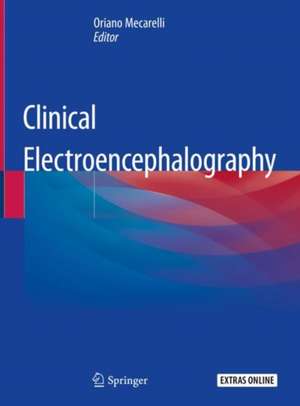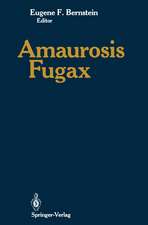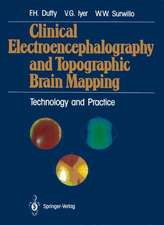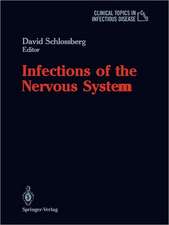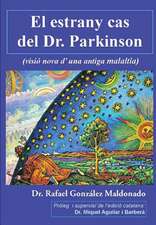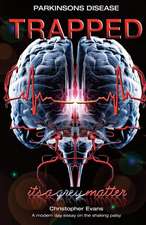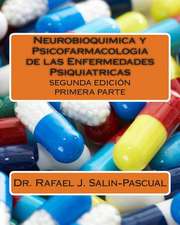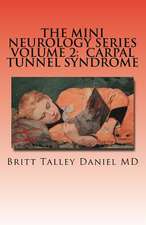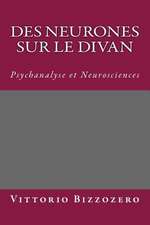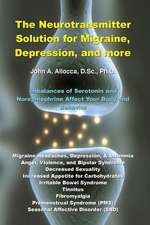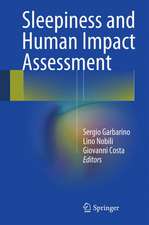Clinical Electroencephalography
Editat de Oriano Mecarellien Limba Engleză Hardback – 20 iun 2019
In clinical practice, EEG still represents the most important functional examination in the study CNS development and its anatomical and physiological integrity throughout life. In the pathological context, EEG provides indispensable diagnostic information for classification of epileptic syndromes, and it is also valuable in all the other CNS diseases (infectious, cerebrovascular, neurodegenerative, etc).
Furthermore, monitoring EEG can be widely used in emergency settings, such as emergency departments or intensive care units. In comatose patients, EEG provides information regarding prognosis and evaluation of the sedative effect of anesthetic drugs.
Written by a group of leading national and international experts, it offers a substantial, yet practical, EEG compendium, which serves as a reference resource for physicians and neurodiagnostic technologists as well as physicians-in-training, researchers, practicing electroencephalographers and students.
Preț: 1394.72 lei
Preț vechi: 1468.12 lei
-5% Nou
Puncte Express: 2092
Preț estimativ în valută:
266.88€ • 275.33$ • 222.71£
266.88€ • 275.33$ • 222.71£
Carte disponibilă
Livrare economică 05-19 martie
Preluare comenzi: 021 569.72.76
Specificații
ISBN-13: 9783030045722
ISBN-10: 3030045722
Pagini: 883
Ilustrații: XIX, 822 p. 726 illus., 383 illus. in color. With online files/update.
Dimensiuni: 210 x 279 x 39 mm
Greutate: 3.18 kg
Ediția:1st ed. 2019
Editura: Springer International Publishing
Colecția Springer
Locul publicării:Cham, Switzerland
ISBN-10: 3030045722
Pagini: 883
Ilustrații: XIX, 822 p. 726 illus., 383 illus. in color. With online files/update.
Dimensiuni: 210 x 279 x 39 mm
Greutate: 3.18 kg
Ediția:1st ed. 2019
Editura: Springer International Publishing
Colecția Springer
Locul publicării:Cham, Switzerland
Cuprins
Preface.- Part I. Technical Aspects and Normal EEG Patterns.- History of EEG.- Neurophysiological Basis of EEG.- Electrodes and Montages.- Acquisition of EEG signals.- Computed Analysis of EEG signals.- Organization of EEG Laboratory.- Artifacts.- Normal wake EEG.- Normal sleep EEG.- Neonatal Normal EEG.- Pathological and unusual EEG Pattern.- Activation Procedures.- Polygraphic techniques.- Polygraphic investigations and back-averaging techniques.- Ambulatory EEG.- Video-Electroencephalography.- Invasive EEG.- High Density-EEG, MEG and Electromagnetic Source Imaging.- Simultaneous registration of EEG and fMRI.- Part II. Pathological EEG Patterns.- Neonatal pathological Patterns.- Early-onset Epileptic Encephalopathies.- Epileptic Encephalopathies of Infancy and Childhood.- Focal “Idiopathic” Epilepsies of infancy.- Focal Epilepsies non age-related by various etiology.- Generalized Genetic Epilepsies.- Reflex Epilepsies.- Photosensitivity and Epilepsy.- Febrile seizures and Febrile SE.- Pediatric Status Epilepticus.- Status Epilepticus in Adults.- Cromosomopathy and Cortical Malformations.- Paroxysmal Nonepileptic seizures.- Sleep Diseases.- Craniocerebral Trauma.- Cerebral Tumors.- Cerebrovascular Disease.- Cerebral inflammatory-infective Disease.- Aging and Degenerative disorders.- Systemic and Dismetabolic Disorders.- Headache.- Psychiatric Disorders.- Effects on EEG of Drugs and Toxic Substances.- Coma and Brain Death.- Emergency EEG and Neuromonitoring in Surgery Room and ICU.-Appendix.- Glossary and EEG Reports.
Notă biografică
Professor Oriano Mecarelli, Researcher Professor at the Department of Human Neurosciences, Sapienza University of Rome, is the Chairman of the Degree in Neurophysiopathological Techniques and Chairman of Center for the Diagnosis and Therapy of Epileptic Syndromes, Neurophysiopathology Unit, Sapienza University of Rome, University Hospital Policlinico Umberto 1°, Rome. His main area of interest is electroencephalography and clinical epileptology. He is President of the Italian League against Epilepsy (LICE), member of the executive committee of the Italian Society of Clinical Neurophysiology (SINC) and member of the Italian Society of Neurology (SIN). Prof. Mecarelli has published several papers in international journals and he is author of an Italian textbook entitled “Manuale Teorico Pratico di Elettroencefalografia” published by Wolters Kluwer Health in 2009.
Textul de pe ultima copertă
This book describes the developments and improvements in electroencephalography (EEG). In recent years, digital technology has replaced analog equipments, and it is now possible to easily record and store EEG tracings and to quickly recall previously acquired material for subsequent analysis. In addition, not only static figures, but also electronic supplementary materials can be included in books, enabling EEGs to be viewed in real-time.
In clinical practice, EEG still represents the most important functional examination in the study CNS development and its anatomical and physiological integrity throughout life. In the pathological context, EEG provides indispensable diagnostic information for classification of epileptic syndromes, and it is also valuable in all the other CNS diseases (infectious, cerebrovascular, neurodegenerative, etc).
Furthermore, monitoring EEG can be widely used in emergency settings, such as emergency departments or intensive care units. In comatose patients, EEG provides information regarding prognosis and evaluation of the sedative effect of anesthetic drugs.
Written by a group of leading national and international experts, it offers a substantial, yet practical, EEG compendium, which serves as a reference resource for physicians and neurodiagnostic technologists as well as physicians-in-training, researchers, practicing electroencephalographers and students.
In clinical practice, EEG still represents the most important functional examination in the study CNS development and its anatomical and physiological integrity throughout life. In the pathological context, EEG provides indispensable diagnostic information for classification of epileptic syndromes, and it is also valuable in all the other CNS diseases (infectious, cerebrovascular, neurodegenerative, etc).
Furthermore, monitoring EEG can be widely used in emergency settings, such as emergency departments or intensive care units. In comatose patients, EEG provides information regarding prognosis and evaluation of the sedative effect of anesthetic drugs.
Written by a group of leading national and international experts, it offers a substantial, yet practical, EEG compendium, which serves as a reference resource for physicians and neurodiagnostic technologists as well as physicians-in-training, researchers, practicing electroencephalographers and students.
Caracteristici
Offers a ready consultation text for physicians and neurodiagnostic technologists
Introduces readers to the technical and methodological aspects of EEG
Defines the physiological patterns of awakeness and sleep
Uses a didactic and systematic method to demonstrate the electrophysiological and clinical patterns of epileptic syndromes
Provides practical examples of the most appropriate EEG methods for different pathologies (video EEG, back averaging, neuromonitoring, etc.)
Supplies indications for immediate and correct interpretation of EEG patterns in emergency situations, during neuromonitoring in Intensive Care Unit and surgery
Defines the EEG peculiarities of the different etiologies of coma
Includes an updated section on EEG in brain tumors
Offers a practical, easy-to-use approach to using and interpreting polysomnography in epileptic and non-epileptic disorders
Introduces readers to the technical and methodological aspects of EEG
Defines the physiological patterns of awakeness and sleep
Uses a didactic and systematic method to demonstrate the electrophysiological and clinical patterns of epileptic syndromes
Provides practical examples of the most appropriate EEG methods for different pathologies (video EEG, back averaging, neuromonitoring, etc.)
Supplies indications for immediate and correct interpretation of EEG patterns in emergency situations, during neuromonitoring in Intensive Care Unit and surgery
Defines the EEG peculiarities of the different etiologies of coma
Includes an updated section on EEG in brain tumors
Offers a practical, easy-to-use approach to using and interpreting polysomnography in epileptic and non-epileptic disorders
